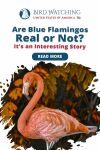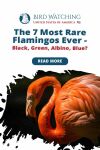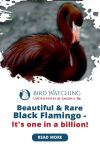
What’s This Post About?
The flamboyant, long-legged flamingos with their bright pink plumages are one of the most striking birds. Identified by their long necks, skinny legs, and long keeled beaks, the flamingos are among the biggest birds in the kingdom.
Getting their name for their vibrant physical appearance, the name derives from the Spanish word ‘Flamenco,’ which means “flame-colored” - referring to the radiant pinkish-orange feathers of the bird.
Blue Flamingos do not exist in reality. The tales of Blue flamingos are false since these stunning birds can only be found in the beautiful hues of orange, pink, and red. They get their coloration from ingesting carotenoid-rich foods deposited in their tufty feathers and skin.

Are there Blue Flamingos?
The internet is brimmed with accounts and images of stunning blue flamingos. We all know and might have even sighted the bright orange pinkish long-necked birds, but have we ever, beyond the realms of our screen, actually seen the blue ones?
No!
That’s because tales of blue flamingos are a ludicrous hoax. Blue flamingos do not exist in nature. Narratives of blue flamingos being spotted are absolutely false and have been creatively invented.
If you’re contemplating whether these flamingos are now extinct, the answer is no. There are no signs of the remains of the existence of these species ever over the centuries.

Surfing on the internet for Blue Flamingos, you’ll come across a multitude of articles and images depicting the existence of blue flamingos.
In reality, these are simply false claims, and no such blue-colored flamingos exist in the world. Any images that you see on the internet are a product of image delusion, not corporality.
Are There Any Blue Species Of Flamingos?

According to the research that has been conducted thus far, there are six species of flamingos.
These include:
- Greater Flamingo
- Lesser Flamingo
- Chilean Flamingo
- Andean Flamingo
- James Flamingo
- American Flamingo
Varying in shades of light pink to the gorgeous darker hues or bright pink, none of these flamingos are even slightly blue.
The ravishing color trait of the bird is not a hereditary feature. Instead, these birds get their bright pink-colored skin and feathers from the pigment in the food they consume.
Even though all species of flamingos have slight variations in their plumage color and relative size, which can be attributed to the differences in habitats and the diets they consume, none of them have blue-colored feathers.
Where Do Flamingos Live?

Flamingos are water birds, usually dwelling in wetlands such as large lakes, lagoons, tidal flats, and even mangrove swamps.
Gregarious in nature, you’re likely to sight a large flock wading in the water, swooping their neck down to filter and feed on their favorite foods. Typically, countless of them reside together in a single colony.
These gorgeous species inhabit various regions of the planet, ranging from the Caribbean to South America and Africa to India and the Mediterranean.
What Do Flamingos Eat?

In the case of flamingos, we could rightly say that these birds are what they eat.
The wading Flamingoes are filter feeders, typically feeding on delicacies enriched with carotenoid pigments deposited into their skin and feathers. These omnivore species’ diet mainly comprises blue, green algae, crustaceans, molluscs, larva, small insects, shrimps, and fish.
Among the richest sources of carotenoid are algae and various invertebrates, making up a large proportion of a flamingo’s diet.
Why Are Flamingos Pink?

Flamingoes attain their spectacular rosy color from the pigment present in their diet. The deposition of the pigment produces the color on the feathers, skin, and legs of the birds. Ingesting substantial amounts of these pigments is vital for the pigment to be laid in the feathers and skin. Since the flamingo diet largely comprises carotenoid-filled organisms, attaining bright colors is no challenge.
Once the flamingos ingest the carotenoids, the enzymes work to break down the carotenoid into pigments deposited in the growing feathers and skin of the flamingos. This peculiar metabolism of the flamingos produces enhanced color results in the feathers of the bird.
Read this post and explore another fascinating bird that gets its exquisite plumage colors from the carotenoid pigment.
What Color Are Cardinals? The 4 Possible Colors
Cardinals are attractive birds which come in various colors and shades but some are more common than others.
What Causes The Color Variation In Flamingos?

One of their kind, flamingos, can ingest carotenoid through the organisms they eat and use their metabolism to convert the food pigments into their pink-colored feathers. However, not all flamingos have the same rosy color.
Consuming high alpha and beta carotene levels, which contains an orange-red pigment, reflects in the bright feathers of the flamingo. The brightness of the feathers can be determined by the level of cateronoid these birds consume in their food.
For this reason, there are visible differences in the plumages of different species of flamingos. Those with high carotenoid content have bright red-orange feathers, while flamingos inhabiting the drought-ridden regions are much paler in the shade.
Some flamingos contain only tints of pink, while some have predominantly pink feathers with streaks of white.
FUN FACT
Though most evident in the flamingo's plumage, the bright coloration of the carotenoid extends to the flamingo's skin as well as the blood, giving them a pink color.
Having a Flamingo visit your yard is not quite possible. Instead, consider purchasing these aesthetic Flamingo sculptures if you want to add a touch of flamingos in your yard.
Houssy 38-40 Inch Flamingos Garden Statues Decor
Houssy flamingo yard statues are made with high-quality iron and hand-finished with an outdoor rustproof paint coat.
Can Flamingos Turn Blue If We Feed Them Blue Pigments?

The major proportion of the flamingo’s diet comes from the green-blue algae. This often makes one wonder if this color relation could convert the bird’s plumage into blue or even green shades if they are fed greater amounts of blue pigmented food.
That’s not the case. All color pigments that the Flamingos consume do not end up giving their feathers the corresponding color.
Flamingos indeed get their pink color from the food they eat, and there are slight variations in the shades of their plumage, depending on their diet. This is because, genetically, flamingos only produce the enzyme that converts the cateronoid pigment into reddish-pink color, thus giving the bird its bright plumage.
Black Flamingos – Are They Real?
Yes, an extreme rarity, though! Do you know that a Black Flamingo was spotted in Cyprus back in 2015? Amidst a massive flock of rosy pink and white feathered flamingos, a conspicuously black plumaged bird with the same physical features was seen in the Mediterranean Island.
Another black flamingo was observed earlier in 2013 in Israel. However, it remains an enigma whether this Black Flamingo is the same, which is quite possible since flamingos are known to migrate for long distances.
The uncommon black plumage of the flamingo is the result of a genetic condition known as Melanism. A number of birds are affected by this condition which causes excessive pigment production in the body of the organism, darkening the feathers. In addition, high levels of pigment deposition in the feathers cause them to become relatively fragile.

Keep Reading!
If you’ve been hoping to sight a Blue Flamingo one day, you now know that they don’t exist. All stories ever heard about Blue Flamingos are fake. They are beautiful in their lusciously bright pinkish-red colors.
These gorgeous, long-necked birds with slender legs get their pinkish-red pigment from the pigments in the food they eat. Their special metabolism gives them stunning coloration.
Though flamingos aren’t blue-colored, numerous other birds add a flash of blue to our environment. You would be amazed to read about 16 birds with blue heads .
16 Astounding Birds with Blue Heads with Pictures! (Backyard friendly)
Here is a list of blue-headed birds found commonly in the USA. The post consists of everything you should know about stunning bluebirds.

By David A. Swanson
Bird Watching USA
My name is David and I'm the the founder of Bird Watching USA! I started Bird Watching with My father-in-law many years ago, and I've become an addict to watching these beautiful creatures. I've learnt so much over about bird watching over the years that I want to share with the world everything I know about them!

David A. Swanson
Bird Watching USA
My name is David and I'm the the founder of Bird Watching USA! I started Bird Watching with My father-in-law many years ago, and I've become an addict to watching these beautiful creatures. I've learnt so much over about bird watching over the years that I want to share with the world everything I know about them!











